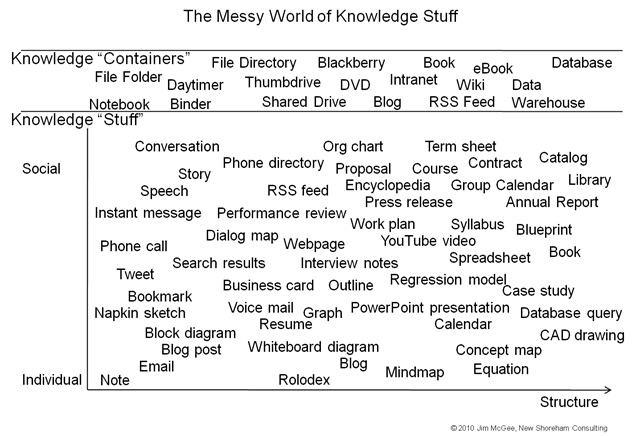I’m back from last week’s Traction User’s Group meeting, TUG2010, where Greg Lloyd graciously asked me to do the opening keynote. I’ve posted the slides on Slideshare and wanted to add some further commentary here.
First, one caution; when I do use slides I don’t design them to be standalone documents. There are too many bullet points in the world as it is. What I’d like to do here is highlight and elaborate on some of the key points I was trying to make.
Peter Drucker first called our attention to the importance of knowledge workers decades ago. The rest of us are slowly catching up to his ideas. One shift in focus that I’ve begun to emphasize is toward the knowledge work itself and away from the notion of knowledge worker as somehow distinct from other kinds of workers. Trying to distinguish who may or may not be a knowledge worker as opposed to some other kind of worker simply perpetuates pecking order games that do little to further the mission of an enterprise. We all do knowledge work to some degree or another, we are all doing more knowledge work than before, and the important question is how to do that work more effectively.
The notions of visibility and observability have been central to my thinking for some time now. The evidence is clear that dealing with complex problems and thinking requires a certain amount of corresponding complexity and mess in our working environments. To those whose focus is on stability and operational control, mess, of course, is disturbing. So disturbing that we ridicule those who deviate from the presumed ideal. We do so at a greater organizational cost than we realize, however, when we ignore the complexity in the environment that is driving the mess.
I introduced the following simple map to suggest just how unavoidably messy the real world of knowledge work can be. The x-axis maps the inherent structure of the knowledge “stuff” we encounter; the y-axis maps the degree to which knowledge stuff is individual or social. It didn’t take long to identify a multitude of items and objects that you might routinely encounter as you go about your work.
It’s tempting to simplify this reality in some way. Many years ago P&G was famed for teaching its managers to distill their arguments into one-page memos. Too many consultants and speakers opt to squeeze all of their output into slideuments; which merely transfers the problem somewhere else. Senior executives rely on staffs to filter the stream at the risk of filtering out the essential insight or data point that truly informs.
The strategy I prefer is to accept the fundamental messiness and seek ways to tame it enough to make it manageable. Part of that relies on exploiting the natural pattern-seeking, pattern-matching capabilities of the human mind. Part relies on enlisting the pattern management capabilities of the other human minds in the system to supplement your own capacity. Both of which also need to be tempered by appreciation for the limits of those same capabilities.
Taming the mess breaks into three layers of practices:
- Hygiene. The proliferation of objects in a physical office offer a host of clues about their contents and relative importance; size, shape, color, location on a shelf or desktop, position in a stack, etc. In a digital environment you need to provide the equivalent of those clues explicitly and consciously. Seemingly mundane decisions about the file names you choose, for example, can make large differences when you are later scanning through a page of search results. Most of today’s systems provide little real assistance in this arena; you and your teams need to develop their own standards for naming files, managing versions, and other details of the knowledge stuff they work with.
- Metadata. i wish there were a more homespun term for this layer. One of the central tricks to taming the flood of data and information that constitute your digital world is to add more data to the flood. The ability to tag the items you create or encounter with labels that are meaningful to you greatly leverages the other tools at your disposal. Merge those tags with the tags of those in your social network and you shorten the path to finding what you are searching for still further, either on your own or through your network’s help.
- Context. One of the least appreciated aspects of messiness in the physical world is the context it provides. There’s a story attached to each pile and object; a story that can be triggered by its context. The power of this context is why students do better on tests when they take them in the same classroom they took the course in than in a random room. A filename in a directory listing or a document displayed on a monitor lack this ready context and are poorer for it. The alternative is to become more mindful of the importance of context and make an effort to capture it explicitly and contemporaneously. This is rationale behind such notions as narrating your work, and developing a digital portfolio.
There is a payoff to all of this for both individuals doing knowledge work and the organizations they contribute to. Once again Peter Drucker said it first; “the most valuable asset of a 21st century institution will be its knowledge workers and their productivity.” Economic growth in this century depends on our ability to improve knowledge work productivity; until you can see it, you can’t improve it.
